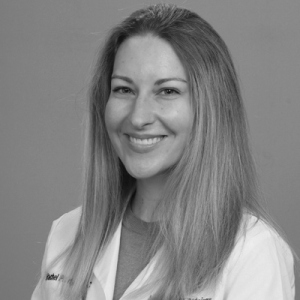Clinical Corner
QWhat is Ear Molding?
Medically reviewed by Nick Brownstone, MD
When my daughter was born with a folded helical rim, I assumed that there was nothing that could be done other than to wait and see if it popped out as she grew, or for her to undergo surgery down the road if its appearance bothered her. Since she had a normal hearing test at birth, my husband and I didn’t bring it up to the pediatrician and I suppose it was subtle enough that the pediatrician didn’t notice during her first couple visits.
At her two-month appointment, however, I decided to mention it, and after an e-consult with ENT, it turns out there was an easy, non-surgical treatment option called ear molding. Since some of us see young pediatric patients for various things, and this is something that parents can actually do at home and is a very affordable fix when an ear lobe abnormality is caught early enough, I think it’s worth discussing in case it’s noted during a neonate exam.
Ear splinting/molding works the fastest when it’s done in an infant below 6 weeks of age because their cartilage is still very soft and pliable from mom’s estrogen floating around in their system. After 6 weeks of age, the time the child has to wear the ear splint becomes much longer, and treatment efficacy goes down. The rule of thumb is that the child will wear the ear mold for as many weeks as they are old. So, if ear splinting is started at two weeks of age, they’ll wear it for about two weeks. If started at 8 weeks, the child will usually have to wear it for 8 weeks. The good news is ear splints aren’t painful! But beyond 6 months of age, it’s probably too late for ear molding and I would just have this patient follow up with ENT or Plastics.
For those newborns in whom an ear deformity is caught early enough, EarBuddies is the splinting kit that parents can order with step-by-step instructions included in the kit, which are also found online. It was started in 1990 by UK Plastic Surgeon Dr. David Gault to treat his newborn son non-surgically, and this method is now utilized by Boston Children’s Hospital, the Mayo Clinic, and the NHS among other institutions including Children’s Hospital here in Denver where I reside. Dr. Gault published the results of his splintage technique in 1994.
In 2013 the Royal College of Surgeons recommended that information should be provided by those advising the parents of babies at the time of their first hearing test, and splintage should soon become common practice as more health professionals become aware of how effectively EarBuddies can help. EarBuddies currently ships to every country in the world. It takes about 2 weeks to arrive, so I would recommend parents order it as they try to get into an ENT specialist, and they can start the splinting process at home or in your office in the meantime. The cost of the basic kit is $97. Among types of ear deformities it can fix are stick-out ears, Stahl’s bar, cup ear, lop ear, cryptotia, and a folded-over helical rim.
In a study of neonatal ear splinting of 82 neonates at the Welsh Centre for Burns and Plastic Surgery, 93% had improved/excellent results as determined by the clinician at the end of treatment, and longer-term parent evaluation showed improved/excellent result in 79% of these children. And in a systematic review and meta-analysis involving a total of 1729 children undergoing molding of 2508 ears, an overall success rate determined by clinician assessment in eight studies was seen in 87.4% of ears. Meta-analysis of three studies with reported efficacy as assessed by laypersons showed an overall success rate of 92%. All studies reported a variety of minor skin-related complications in the ear, such as eczema, excoriation, infection, irritation, rash (allergic or nonallergic), and ulceration. Generally, complications were not reported to be serious and were noted to resolve with minimal to no intervention. Ear splinting is generally tolerated well and can even be applied while the infant is sleeping or nursing. In another study published in 2023 by the Journal of Plastic and Reconstructive Surgery – Global Open it was noted that infants who had some of these complications such as eczematous dermatitis and pressure ulcers were much more likely to achieve only a partial result compared to a complete response, which is where we as dermatology providers can help manage these infants’ skin as they undergo treatment to help them get the best response possible.
The sooner ear molding is started the better, however, with favorable results most likely if started prior to 6 weeks due to the pliability of the cartilage at that time. In one study by the Journal of Plastic, Reconstructive & Aesthetic Surgery, 209 ears underwent molding, and for protruding ears, a reasonable chance of success can only be offered to parents of children up to 6 weeks old. However, success was seen more often for deformity of a flat antihelix beyond six weeks of age, but time spent in the splint was much longer. So, the sooner we as clinicians can identify ear anomalies in neonates and start the patient on ear molding, the less likely the child will need corrective ear surgery down the road, saving the child from potential teasing and the parents from a huge bill.
It is recommended that ear molding be done under the supervision of a plastic surgeon or pediatric ENT physician. However, it is good for dermatology providers to be aware of this easy and non-surgical method of correcting congenital ear deformities.
References:
- Javed, M, Jones N. Neonatal ear splinting for congenital ear deformities. Journal of Plastic, Reconstructive & Aesthetic Surgery. 2020 Dec.
- Elias S Saba et al. Noninvasive ear molding in the correction of ear anomalies: A systematic review and meta-analysis. Int J Pediatr Otorhinolaryngol. 2022 Aug.
- M P van Wijk et al. A prospective study on non-surgical correction of protruding ears: the importance of early treatment. J Plast Reconstr Aesthet Surg. 2012 Jan.
- Jamasb J Sayadi et al. A retrospective review of outcomes and complications after infant ear molding at a single institution. Plast Reconstr Surg Glob Open. 2023 Aug.



